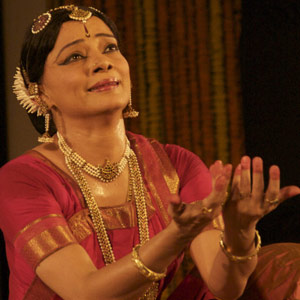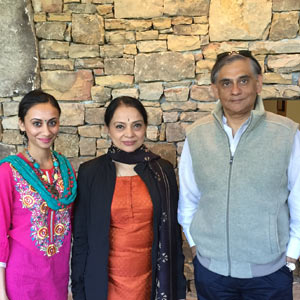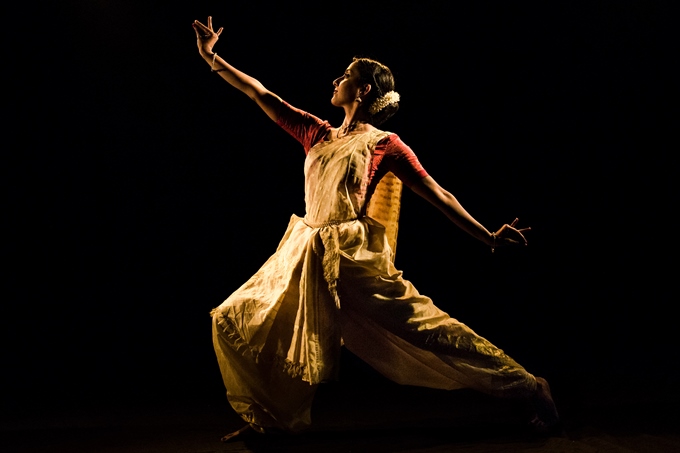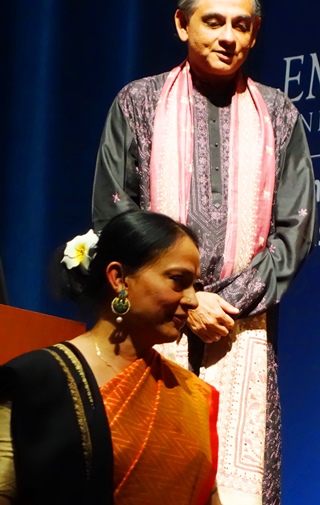Arts: “There’s great profundity in the classical arts”

…says Padmashree Award-winning Bharatnatyam dancer Malavika Sarukkai in an interview with Shemoni Parekh, Artistic Director of Kruti Dance Academy.
Established in 2000 as the brainchild of Dr. Jagdish and Mrs. Madhu Sheth, the Emory University Sheth Lecture Series in Indian Studies is dedicated to raising awareness of Indian culture. This year’s lecture featured a documentary screening of The Unseen Sequence: Exploring Bharatanatyam through the Art of Malavika Sarukkai, and remarks from the film’s focus, Malavika Sarukkai, and its director, Sumantra Ghosal.
Sarukkai, a Bharatanatyam virtuoso, has dedicated her life to performing and propagating this ancient art form of India. In recognition for her contribution to classical dance, she has received many awards including the Padmashree from the President of India, the SNA Award 2002 from the Central Sangeet Natak Akademi, Delhi, and the Kalaimamani award from the Government of Tamil Nadu.
Sarukkai’s “Unseen Sequence” explores her Bharatanatyam journey, a journey adaptive to contemporary sensibility. Following is a conversation about the evolution of Indian dance and its place in the modern day cultural landscape.

Shemoni Parekh (l) with her interview subjects, Padmashree Award-winning Bharatnatyam dancer Malavika Sarukkai and the director of a documentary on her, Sumantra Ghosal.
What interested you in Bharatanatyam originally
and when did you decide to pursue it as a career?
My mother was very interested in dance. And
soon I found myself in dance school. My mother was
a guide, a motivator. And it went on, I did arangetram,
then I wanted to be more serious about it. At 16 I decided
I wanted to dance. She was supporting me through
it in every possible way. And careers… I don’t know if
I ever thought of it as a career, frankly. I thought of it
as something I loved to do. And it became a career.
And from becoming a career, it became a life’s journey.
So right now, I could certainly not call it a career. I left
it far behind. So it just transformed. You know, different
stages of life, with the depth you give it, what it
gives back to you—it changes. It’s a journey.
How much of your time do you spend teaching
versus performing?
Basically I think I’m an artiste who’s performing
a lot. [I teach] only students who want to pursue
dance in a more serious way, who are more
curious, who want to train or are willing to train—because
training is very demanding, it doesn’t happen
easy. So, teaching is just a small part of my life. It’s basically
performing and choreographing and travelling.
In the documentary, you had mentioned there is
a very big difference between student, performer, and
artist. How do you distinguish the three and what advice
would you give for dancers aspiring to become
Bharatanatyam artists?
I think you cannot want to become an artiste; you
become an artiste if you have it in you. If we are diligent
and if we have the talent, at some point we seem
to become dancers—dancers who are competent, and
they are on the stage, and they know how to deliver,
they know how to present. But from that dancer stage,
to become the artiste... then it becomes a more internal
journey. Because obviously an artiste is somebody who
contributes to the art form, who does something which
has a lasting impact. Which means that that person
must have internalized the art to a certain degree, must
have thought about it, must have a deeper understanding
of it, a deeper quest of it. If a dancer has all that,
then she possibly becomes an artiste. But I don’t think
we can just aim for...like, “after 20 years of training,
I’m going to become an artiste.” I think an artiste
is someone who really gives back to the art form, in a
way. It happens. But a lot has to happen in the dancer.
I don’t think it’s a target. I think it’s a process.
Your documentary was very insightful. One element
of the documentary that I could especially relate
to was the collaborative relationship you had with
your mother. You noted that your mother has now retired
from becoming your manager. Accordingly, how
has your creative process had to evolve from being
one with a collaborative dialogue with your mother?
My mother was a guiding spirit and force behind
this. She left a lot of imprint. And I go with that imprint.
Of course I have to adapt. But then I have people like
Sumantra with whom I can discuss my work. I find different
people who are creative, intellectual, stimulating,
who can talk to me about it. So it continues, but it
has changed. I think this phase requires me to touch
my inner self much more. I have to listen to what is
happening inside, more. Because earlier I could [rely]
on my mother…she had so much of input. So it’s a different
phase, oh yes. As I said, I have also met, or I am
meeting more people who have that intellectual and
sensitive look at the arts with whom I am able to have
dialogues, which is very exciting and I am getting very
fresh perspectives about my dance.

A key concern of many performing artistes is
staying true to yourself despite the outside pressures
of your audience. With the advent of social
media and Bharatanatyam becoming an increasingly
mainstream art form, how do you prevent conforming
to that pressure of modifying your interpretation
of the art?
Faith. You keep faith. I think you have to have integrity,
you know, about what you are doing. You must
have some conviction about why you are doing it.
That becomes important. Because if you are not convinced
then possibly someone else says something,
and you [are impacted]. I think you have to actually redefine
what dance is in the world now because there
is a lot of change; there is all the chatter of social media.
And everybody has so many opinions; you don’t
want an opinion but you can get a 100,000 coming
to you! I think more than ever, you need conviction,
and you need a certain silence in your life, because
if you are open to the chatter all the time, you will
get confused. It’s also interlinked with what is funding,
what is the support for the arts....it’s a very complex
situation. Any thinking dancer would have a
problem, right? They would have a problem to move
across this very sort of uneven terrain. Because there
is no comfort in it. But you have to find it; you have to
try to find yourself: What do you want? Why are you
dancing? What does it mean? Where do you want to
take it? How will you shape it? How will you reinvent
it? These are big questions. You have to have some
sense of the beauty of what you are doing. And you
have to... I think...well, protect yourself from chatter.
Where do you see Bharatanatyam in the next
25 years?
I don’t know. I do hope that in the 20-, 30-year-olds,
that next gen of dancers, we will find some serious, inventive,
intelligent dancers, and I hope they keep going.
I would like to train dancers like that. To give them that
sense of foundation, to give them that sense of conviction
because there is a great profundity in the classical
arts. And I think the world needs it, people need
it, the audience needs it, except they don’t know [that
they need it]. If we show them that space, they appreciate
it, they are grateful. So we need dancers to follow
that, to be able to make it. So 25 years, I have no idea.
But hopefully, we just have some dancers who can
keep the faith.
Bharatanatyam is incredibly demanding both
mentally and physically. What sacrifices have you
made in your personal life and efforts of continuing
to perform? Or have you made any sacrifices?
No, when you take up anything full time like this,
or as I call it, not even full time, it’s more like lifetime....
You give up a lot of things, but you give it up because
it just falls out of your life. But you are enriched by so
much else. You can’t just say, “I didn’t do this, I didn’t
do that”—you can’t live your life like that. If you’re
passionate about something and you give yourself to
it, you do give up a lot, a lot of other things. But then
you find so much, too. If you have to be a serious tennis
player or anything you have to…what do we do?
As a performer, I have noticed differences in my
body as I have gotten older and have continued to
perform; the dance form exerts more of a physical toll
with each passing year. You look to be in immaculate
shape. What do you do to maintain your physicality
and how have you adapted your regimen as you have
gotten older?
You know, this whole thing about regimen… I
didn’t work with all that, because when I learnt from
my gurus, they would simply say, “Dance!” and we
would get up and dance. So we weren’t so thoughtful
or thought out about all the things we have to do:
pre-warmup and cool down, and all. We simply danced.
I think if you have danced with a certain basic alignment
in your body, it keeps going for some time. But
all dancers, like athletes, or anyone who uses their
body, has this wear and tear, so at some point it catches
up. So I think what helps for your muscles to keep
performing the way they need to, is training, flexibility,
and all the rest of it. So training becomes important,
yoga becomes important. So all those things that
one may not have had in the twenties, certainly one
needs. At least in the thirties I think dancers should
definitely start getting into that. Because I think the
whole performing circuit is more taxing now, lifestyles
are more taxing. So they need to take care of their
bodies earlier than when we started actually noticing
that we needed to do something. I think dancers, even
my students, all going to gyms and working on this
and that, are all very aware of the physicality of the
dancing body. I think it’s also about maturity, the kind
of maturity one has later on. The intensity one is able to
get into movement, which you weren’t able to get when
you were in your 20s and 30s.
What is something that you wish to see evolve in
future generations of dancers?
I think they should work on technique. And on
thinking about dance, and the making of dance. Most
times dancers haven’t really given themselves time
to find the dimensions which are hidden. But I think
they can, and if I am able to get them to discover their
own potential, that would be exciting and that is what
I would like to do. Discover their potential, discover
their creativity and, of course, in the process discover
the deeper aspects of dancing. So it’s not just something
superficial or something performative which the
dancers are doing, which is OK at one level, but there
are many other levels. Perhaps dancers are not giving
themselves enough time to stay with it. You know
that Shraddha (faith), you stay with it. Because unless
you stay very alert and very aware of it, you don’t really
find it. So if I can do mentoring sessions which
improve that in them, and help them discover dance,
help them discover their potential, whichever style
they are coming from, it’s not about my style, it’s about
dancing, it’s about the potential of Bharatanatyam.
What does nritta have, what is abhinaya, what is expression,
what is body language, what is intelligence, what
is poetry? How do you work it? What is choreography?
How can I get choreography that is more, not only
exciting, but intelligent? So if that could happen, that
would be wonderful, that would be it.

Sumantra Ghosal follows Malavika Sarukkai down the steps after their panel discussion of the film The Unseen Sequence at Emory University on October 5, 2014 (see Around Town report). (Photo: Suzanne Sen)
Director Sumantra Ghosal on his work with artistes
I read that you used to be in advertising. What inspired you to make the switch from advertising
to film making?
I don’t think it was a function of inspiration. I wasn’t
inspired to make the switch. I think I was tired with what
I was doing. I had done quite a bit of it for a long time and
I wanted to work for myself in things that I thought would
give me growth. I’d had whatever growth that I needed to
in advertising. I wanted to opt out of that and engage with
the world of the arts and emotions and culture and heritage,
and particularly Indian things and roots. It was a very
conscious decision to move out of that hectic, repeatable
world of advertising into stuff that I didn’t know. I knew
advertising. I could do it in my sleep. This stuff, I can’t do
unless I am very alert and wide awake—and I think being
awake and receptive to these new things that have entered
my life has been very enriching. When you can see
a sort of expiry date written on your life, then you want
to do things that are more enriching. So I suppose, all of
those things. I just grew old!
You have created a documentary on Zakir Hussain
and you just created this beautiful documentary on Malavikaji.
Do you plan on making more documentaries
featuring Indian artists?
Unfortunately I am not a very good planner. I was
when I was making advertising. No, I am open to being
inspired. Documentaries, like with Zakir or with Malavika
are not easy to do because they are very tough subjects.
They look sweet but they are very, very quick to judge you
for your own seriousness, integrity, input, intelligence.
And when you are with them for two years as I was with
her or for three years as I was with Zakir over time, you
are very susceptible to being found out. So, it’s not easy
to make a film for them because they have to trust you
and respect you. How I make my films is different. I just
don’t go into it as a project and say, “OK, now I am going
to make a film because somebody has told me to make a
film or somebody’s put up the money to make a film or I
need work.” I go into it because I feel that we converse in
our art, in our emotions, in the way we think about things.
And then, I want that conversation to enrich both of us,
given how much we are going to put into that work. So it’s
a little complicated. It’s not as if I just choose a subject and
say, “OK, hello, I want to make a film on you, are you free
next Tuesday?” It doesn’t work like that; you spend a lot of
time in taking this journey. So I have to think hard about
what I do next.
Any new documentaries on the horizon?
No, as I said, it takes me a long while to find a subject.
If I am going to make another film on an artiste, I need
somebody actually who’s articulate in English because if
she was articulate in Tamil and I was articulate in Bengali,
I don’t think this film would have happened because the
exchange of ideas becomes complicated.
[Malavika Sarrukai]: And I think it’s not only exchange of ideas, it’s that we believe in art. There were many things which we discovered where we didn’t speak but we knew we were thinking along the same lines. There’s more to it, it’s not only discussions…
It’s not discussions only, there’s a sort of attitude to the art. I think both of us in a way, and without sounding arrogant, both of us are self-critical as well as deeply convinced about the art we are engaged in. It’s not a frivolous pastime, it’s not a hobby. It’s an investment of a life. That’s a complicated idea. But you very quickly understand who you share that idea with and you who don’t share that idea with. You can still work together, still engage. But I find it’s difficult to take a complicated, emotional, intellectual journey like the one we’ve taken without that kind of relationship and I have had that [with Malavika].
Enjoyed reading Khabar magazine? Subscribe to Khabar and get a full digital copy of this Indian-American community magazine.
blog comments powered by Disqus












